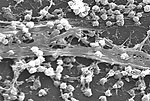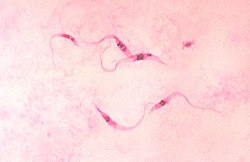Bacterial cellular morphologies are the shapes that are characteristic of various types of bacteria and often key to their identification. Their direct...
24 KB (2,335 words) - 10:50, 7 April 2025
March 2020. Bacterial cellular morphologies—the microscopic appearance of bacterial cells Wikimedia Commons has media related to Colony morphology. Colony...
13 KB (1,306 words) - 17:19, 4 May 2022
Bacterial morphological plasticity refers to changes in the shape and size that bacterial cells undergo when they encounter stressful environments. Although...
31 KB (3,631 words) - 12:11, 27 November 2024
Bacteria generally form distinctive cell morphologies when examined by light microscopy and distinct colony morphologies when grown on Petri plates. Perhaps...
35 KB (4,590 words) - 05:56, 9 November 2024
(number of lipid bilayers) or bilayer composition (see Bacterial cellular morphologies, Bacterial cell structure) Bacteria were first observed by Antonie...
80 KB (9,212 words) - 19:49, 2 April 2025
formation of patterns in the growth of bacterial colonies has extensively been studied experimentally. Resulting morphologies appear to depend on the growth conditions...
4 KB (427 words) - 22:19, 25 January 2020
Type IX secretion system (category Bacterial enzymes)
Fibrobacteres-Chlorobi-Bacteroidetes superphylum. It plays a crucial role in various cellular processes, including gliding motility and the secretion of virulence factors...
20 KB (2,086 words) - 18:00, 11 April 2025
continuously differentiated light fields as well. Bacterial cellular morphologies Colonial morphology Mehdizadeh Allaf, Malihe; Peerhossaini, Hassan (2022-03-24)...
69 KB (6,986 words) - 15:14, 22 August 2024
Flagellum (redirect from Bacterial flagella)
flagellum in archaea is called the archaellum to note its difference from the bacterial flagellum. Eukaryotic flagella and cilia are identical in structure but...
66 KB (7,275 words) - 03:37, 24 March 2025
involved in determining the conservation and diversification of plant morphologies. In these studies transcriptome conservation patterns were found to mark...
38 KB (5,058 words) - 14:02, 11 April 2025
Autophagy (redirect from Cellular autophagy)
mechanisms for removal of cellular and bacterial debris to the principal factors that regulate inflammation: The degradation of cellular components by the lysosome...
79 KB (9,305 words) - 12:54, 3 April 2025
Biofilm (redirect from Bacterial mat)
to bacterial biofilms such as differentiation and HGT, which required cell-cell contact and involved formation of cytosolic bridges and cellular fusion...
121 KB (14,157 words) - 07:20, 9 April 2025
the lifespan of mice. In eukaryotes, catalase is usually located in a cellular organelle called the peroxisome. Peroxisomes in plant cells are involved...
39 KB (4,269 words) - 20:21, 18 March 2025
household bleach. These chemicals inflict extensive cellular damage to different systems such as the bacterial membrane, denaturation of proteins, and interference...
15 KB (2,012 words) - 18:22, 20 January 2025
Lysogenic cycle (section Bacterial survival)
the host bacterium's genome or formation of a circular replicon in the bacterial cytoplasm. In this condition the bacterium continues to live and reproduce...
18 KB (2,137 words) - 17:59, 15 March 2025
In evolutionary biology, the term cellularization (cellularisation) has been used in theories to explain the evolution of cells, for instance in the pre-cell...
18 KB (1,935 words) - 16:21, 13 August 2024
Necrosis (category Cellular processes)
cellular death. While apoptosis often provides beneficial effects to the organism, necrosis is almost always detrimental and can be fatal. Cellular death...
29 KB (3,252 words) - 05:03, 7 March 2025
bacteria and archaea. However, some processes in bacteria, including bacterial conjugation, transformation and transduction, may be considered analogous...
40 KB (4,979 words) - 01:03, 16 February 2025
Endospore (redirect from Bacterial spores)
Most types of bacteria cannot change to the endospore form. Examples of bacterial species that can form endospores include Bacillus cereus, Bacillus anthracis...
27 KB (3,137 words) - 23:44, 3 March 2025
Cell biology (redirect from Cellular biology)
Cell biology (also cellular biology or cytology) is a branch of biology that studies the structure, function, and behavior of cells. All living organisms...
42 KB (5,252 words) - 13:31, 10 April 2025
Trypanosomatida (section Morphologies)
through a range of different morphologies at different stages of the life cycle, with most having at least two different morphologies. Typically the promastigote...
26 KB (2,556 words) - 06:18, 6 April 2025
Bacterial motility is the ability of bacteria to move independently using metabolic energy. Most motility mechanisms that evolved among bacteria also...
109 KB (12,267 words) - 21:41, 14 January 2025
Archaea (category Systems of bacterial taxonomy)
almost 3.5 billion years ago, most prokaryotes do not have distinctive morphologies, and fossil shapes cannot be used to identify them as archaea. Instead...
153 KB (16,713 words) - 06:14, 13 April 2025
including cytokines, growth factors, stress, and bacterial and viral infections. AP-1 controls a number of cellular processes including differentiation, proliferation...
42 KB (4,614 words) - 10:42, 5 February 2025
type – Distinct morphological or functional form of cell. When a cell switches state from one cell type to another, it undergoes cellular differentiation...
36 KB (4,376 words) - 22:18, 24 August 2024
Slime mold (redirect from Cellular slime moulds)
1887, classified the Myxomycetes (plasmodial slime molds) and Acrasieae (cellular slime molds) as Mycetozoa, a new class. He also introduced a "Doubtful...
54 KB (5,529 words) - 17:57, 4 April 2025
Comparative anatomy (redirect from Animal morphology)
Bacteria and fungi Bacterial cell structure cellular morphologies morphological plasticity Colonial morphology Lichen morphology Protists Structures...
12 KB (1,247 words) - 19:27, 8 December 2024
Leptospira (section Cellular structure)
strain identification. Leptospirosis List of bacteria genera List of bacterial orders "leptospirosis". American Heritage Dictionary of the English Language:...
40 KB (3,024 words) - 18:57, 5 February 2025
Swarming motility (section Cellular differentiation)
wild-type Bacillus subtilis strain 3610: detection of different cellular morphologies and constellations of cells as the complex architecture develops"...
12 KB (1,197 words) - 02:46, 20 March 2024


























